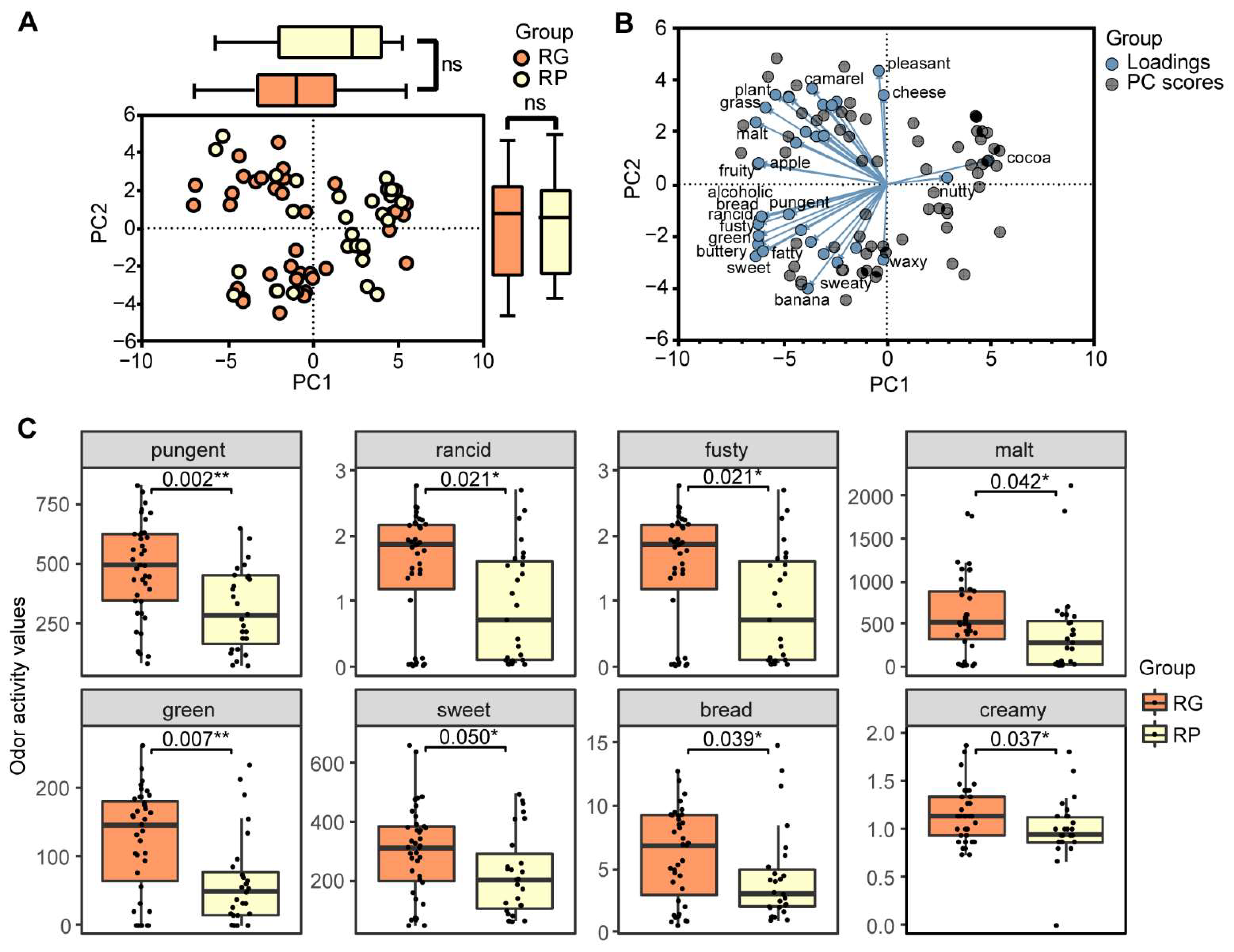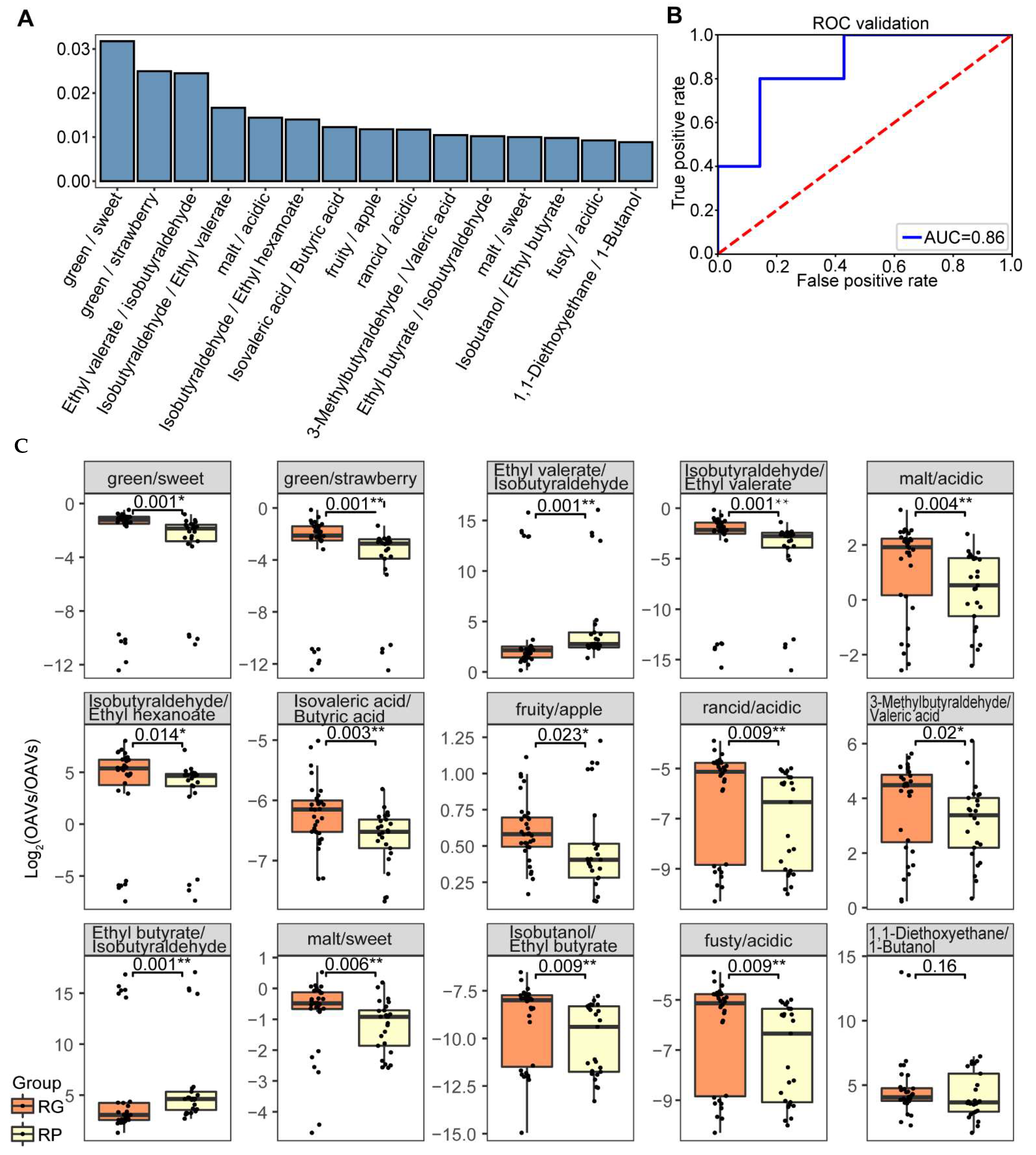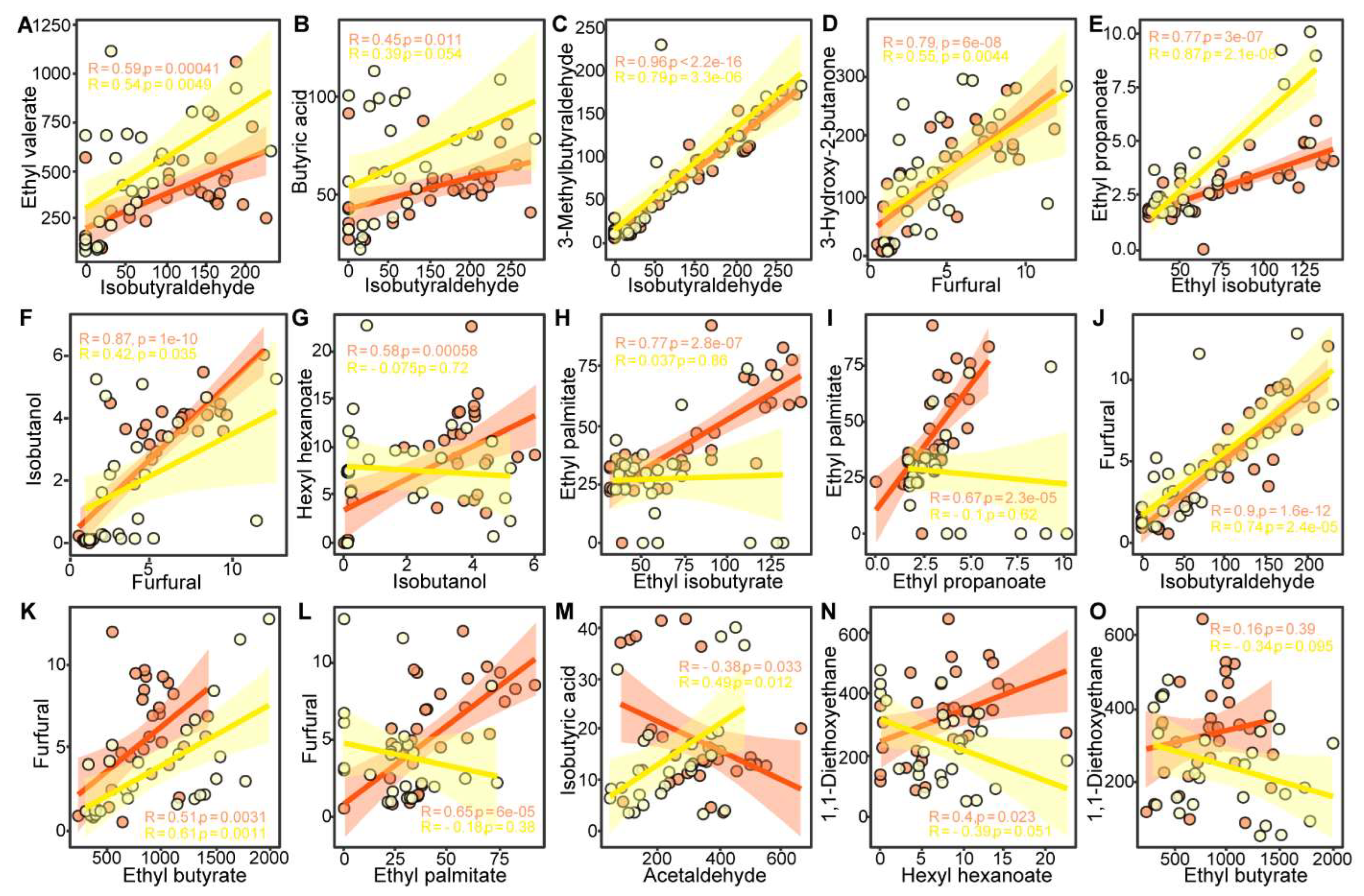Volatile Compound Abundance Correlations Provide a New Insight into Odor Balances in Sauce-Aroma Baijiu
Abstract
1. Introduction
2. Materials and Methods
2.1. Baijiu Samples
2.2. Chemicals
2.3. Sensory Evaluation
2.4. Gas Chromatography with Flame Ionization Detector (GC-FID)
2.5. OAV Ratio-Based Random Forest Classifier
2.6. Statistics
3. Results and Discussion
3.1. The Differences in Aroma Compounds between the Two Groups of SABs
3.2. The Correlation between the Grade of SABs and OAV of Volatiles
3.3. Compound Co-Abundance Correlation Network of SAB of Two Grades
3.4. Important Odor and Compound Sets Selected by OAV Ratio-Based Random Forest Classification between the Two Quality Groups of SABs
3.5. Correlations of Key Compound Sets in SABs
4. Conclusions
Supplementary Materials
Author Contributions
Funding
Data Availability Statement
Conflicts of Interest
References
- Yan, Y.; Chen, S.; Nie, Y.; Xu, Y. Characterization of volatile sulfur compounds in sauce-aroma Baijiu and changes during fermentation by GC× GC-TOFMS, organoleptic impact evaluation, and multivariate data analysis. Food Res. Int. 2020, 131, 109043. [Google Scholar] [CrossRef] [PubMed]
- Duan, J.; Yang, S.; Li, H.; Qin, D.; Shen, Y.; Li, H.; Sun, J.; Zheng, F.; Sun, B. Why the key aroma compound of soy sauce aroma type baijiu has not been revealed yet? LWT 2022, 154, 112735. [Google Scholar] [CrossRef]
- Xu, Y.; Zhao, J.; Liu, X.; Zhang, C.; Zhao, Z.; Li, X.; Sun, B. Flavor mystery of Chinese traditional fermented baijiu: The great contribution of ester compounds. Food Chem. 2022, 369, 130920. [Google Scholar] [CrossRef] [PubMed]
- Zheng, X.-W.; Han, B.-Z. Baijiu (白酒), Chinese liquor: History, classification and manufacture. J. Ethn. Foods 2016, 3, 19–25. [Google Scholar] [CrossRef]
- He, X.; Jeleń, H.H. Comprehensive two-dimensional gas chromatography–time of flight mass spectrometry (GC×GC-TOFMS) in conventional and reversed column configuration for the investigation of Baijiu aroma types and regional origin. J. Chromatogr. A 2021, 1636, 461774. [Google Scholar] [CrossRef]
- He, Y.; Liu, Z.; Qian, M.; Yu, X.; Xu, Y.; Chen, S. Unraveling the chemosensory characteristics of strong-aroma type Baijiu from different regions using comprehensive two-dimensional gas chromatography–time-of-flight mass spectrometry and descriptive sensory analysis. Food Chem. 2020, 331, 127335. [Google Scholar] [CrossRef]
- Jia, W.; Li, Y.; Du, A.; Fan, Z.; Zhang, R.; Shi, L.; Luo, C.; Feng, K.; Chang, J.; Chu, X. Foodomics analysis of natural aging and gamma irradiation maturation in Chinese distilled Baijiu by UPLC-Orbitrap-MS/MS. Food Chem. 2020, 315, 126308. [Google Scholar] [CrossRef]
- Song, X.; Jing, S.; Zhu, L.; Ma, C.; Song, T.; Wu, J.; Zhao, Q.; Zheng, F.; Zhao, M.; Chen, F. Untargeted and targeted metabolomics strategy for the classification of strong aroma-type baijiu (liquor) according to geographical origin using comprehensive two-dimensional gas chromatography-time-of-flight mass spectrometry. Food Chem. 2020, 314, 126098. [Google Scholar] [CrossRef]
- Li, Q.; Gu, Y.; Wang, N.-F. Application of Random Forest Classifier by Means of a QCM-Based E-Nose in the Identification of Chinese Liquor Flavors. IEEE Sens. J. 2017, 17, 1788–1794. [Google Scholar] [CrossRef]
- Hu, S.; Wang, L. Age Discrimination of Chinese Baijiu Based on Midinfrared Spectroscopy and Chemometrics. J. Food Qual. 2021, 2021, 5527826. [Google Scholar] [CrossRef]
- Xu, M.L.; Yu, Y.; Ramaswamy, H.S.; Zhu, S.M. Characterization of Chinese liquor aroma components during aging process and liquor age discrimination using gas chromatography combined with multivariable statistics. Sci. Rep. 2017, 7, 39671. [Google Scholar] [CrossRef] [PubMed]
- Zhang, X.-J.; Meng, L.-J.; Lu, Z.-M.; Chai, L.-J.; Wang, S.-T.; Shi, J.-S.; Shen, C.-H.; Xu, Z.-H. Identification of age-markers based on profiling of Baijiu volatiles over a two-year maturation period: Case study of Lu-flavor Baijiu. LWT 2021, 141, 110913. [Google Scholar] [CrossRef]
- Cheng, P.; Fan, W.; Xu, Y. Quality grade discrimination of Chinese strong aroma type liquors using mass spectrometry and multivariate analysis. Food Res. Int. 2013, 54, 1753–1760. [Google Scholar] [CrossRef]
- Zhu, L.; Wang, X.; Song, X.; Zheng, F.; Li, H.; Chen, F.; Zhang, Y.; Zhang, F. Evolution of the key odorants and aroma profiles in traditional Laowuzeng baijiu during its one-year ageing. Food Chem. 2020, 310, 125898. [Google Scholar] [CrossRef] [PubMed]
- Nizampatnam, S.; Saha, D.; Chandak, R.; Raman, B. Dynamic contrast enhancement and flexible odor codes. Nat. Commun. 2018, 9, 3062. [Google Scholar] [CrossRef]
- Wang, L.; Fan, S.; Yan, Y.; Yang, L.; Chen, S.; Xu, Y. Characterization of Potent Odorants Causing a Pickle-like Off-Odor in Moutai-Aroma Type Baijiu by Comparative Aroma Extract Dilution Analysis, Quantitative Measurements, Aroma Addition, and Omission Studies. J. Agric. Food Chem. 2020, 68, 1666–1677. [Google Scholar] [CrossRef] [PubMed]
- Niu, Y.; Zhang, J.; Xiao, Z.; Zhu, J. Evaluation of the Perceptual Interactions Between Higher Alcohols and Off-Odor Acids in Laimao Baijiu by σ–τ Plot and Partition Coefficient. J. Agric. Food Chem. 2020, 68, 14938–14949. [Google Scholar] [CrossRef] [PubMed]
- Thomas-Danguin, T.; Sinding, C.; Romagny, S.; El Mountassir, F.; Atanasova, B.; Le Berre, E.; Le Bon, A.-M.; Coureaud, G. The perception of odor objects in everyday life: A review on the processing of odor mixtures. Front. Psychol. 2014, 5, 504. [Google Scholar] [CrossRef] [PubMed]
- Shannon, P.; Markiel, A.; Ozier, O.; Baliga, N.S.; Wang, J.T.; Ramage, D.; Amin, N.; Schwikowski, B.; Ideker, T. Cytoscape: A software environment for integrated models of Biomolecular Interaction Networks. Genome Res. 2003, 13, 2498–2504. [Google Scholar] [CrossRef]
- Fan, W.; Xu, Y.; Qian, M. Current practice and future trends of aroma and flavor research in Chinese Baijiu. In Sex, Smoke, and Spirits: The Role of Chemistry; American Chemical Society: Washington, DC, USA, 2019; pp. 145–175. [Google Scholar]
- Niu, Y.; Zhu, Q.; Xiao, Z. Characterization of perceptual interactions among ester aroma compounds found in Chinese Moutai Baijiu by gas chromatography-olfactometry, odor Intensity, olfactory threshold and odor activity value. Food Res. Int. 2020, 131, 108986. [Google Scholar] [CrossRef]
- He, Y.; Tang, K.; Yu, X.; Chen, S.; Xu, Y. Identification of Compounds Contributing to Trigeminal Pungency of Baijiu by Sensory Evaluation, Quantitative Measurements, Correlation Analysis, and Sensory Verification Testing. J. Agric. Food Chem. 2022, 70, 598–606. [Google Scholar] [CrossRef] [PubMed]
- Regueiro, J.; Negreira, N.; Simal-Gándara, J. Challenges in relating concentrations of aromas and tastes with flavor features of foods. Crit. Rev. Food Sci. Nutr. 2017, 57, 2112–2127. [Google Scholar] [CrossRef] [PubMed]
- Li, H.; Qin, D.; Wu, Z.; Sun, B.; Sun, X.; Huang, M.; Sun, J.; Zheng, F. Characterization of key aroma compounds in Chinese Guojing sesame-flavor Baijiu by means of molecular sensory science. Food Chem. 2019, 284, 100–107. [Google Scholar] [CrossRef] [PubMed]
- Zheng, Y.; Sun, B.; Zhao, M.; Zheng, F.; Huang, M.; Sun, J.; Sun, X.; Li, H. Characterization of the key odorants in Chinese zhima aroma-type baijiu by gas chromatography–olfactometry, quantitative measurements, aroma recombination, and omission studies. J. Agric. Food Chem. 2016, 64, 5367–5374. [Google Scholar] [CrossRef]
- Cai, W.; Wang, Y.; Wang, W.; Shu, N.; Hou, Q.; Tang, F.; Shan, C.; Yang, X.; Guo, Z. Insights into the Aroma Profile of Sauce-Flavor Baijiu by GC-IMS Combined with Multivariate Statistical Analysis. J. Anal. Methods Chem. 2022, 2022, 4614330. [Google Scholar] [CrossRef]
- Wang, M.; Yang, J.-G.; Zhao, Q.; Zhang, K.; Su, C. Research Progress on Flavor Compounds and Microorganisms of Maotai Flavor Baijiu. J. Food Sci. 2019, 84, 6–18. [Google Scholar] [CrossRef]
- Wang, Z.; Sun, X.; Liu, Y.; Yang, H. Characterization of Key Aroma Compounds in Xiaoqu Liquor and Their Contributions to the Sensory Flavor. Beverages 2020, 6, 42. [Google Scholar] [CrossRef]
- Rice, S.; Koziel, J.A. The relationship between chemical concentration and odor activity value explains the inconsistency in making a comprehensive surrogate scent training tool representative of illicit drugs. Forensic Sci Int. 2015, 257, 257–270. [Google Scholar] [CrossRef]
- Ferreira, V.; López, R.; Cacho, J.F. Quantitative determination of the odorants of young red wines from different grape varieties. J. Sci. Food Agric. 2000, 80, 1659–1667. [Google Scholar] [CrossRef]
- Niu, Y.; Zhang, X.; Xiao, Z.; Song, S.; Eric, K.; Jia, C.; Yu, H.; Zhu, J. Characterization of odor-active compounds of various cherry wines by gas chromatography-mass spectrometry, gas chromatography-olfactometry and their correlation with sensory attributes. J. Chromatogr. B Anal. Technol. Biomed. Life Sci. 2011, 879, 2287–2293. [Google Scholar] [CrossRef]
- Peinado, R.A.; Mauricio, J.C.; Moreno, J. Aromatic series in sherry wines with gluconic acid subjected to different biological aging conditions by Saccharomyces cerevisiae var. capensis. Food Chem. 2006, 94, 232–239. [Google Scholar] [CrossRef]
- Niu, Y.; Liu, Y.; Xiao, Z. Evaluation of Perceptual Interactions between Ester Aroma Components in Langjiu by GC-MS, GC-O, Sensory Analysis, and Vector Model. Foods 2020, 9, 183. [Google Scholar] [CrossRef] [PubMed]
- Fan, W.; Qian, M.C. Identification of aroma compounds in Chinese ‘Yanghe Daqu’liquor by normal phase chromatography fractionation followed by gas chromatography [sol] olfactometry. Flavour Fragr. J. 2006, 21, 333–342. [Google Scholar] [CrossRef]
- Yan, Q.; Zhang, K.; Zou, W.; Hou, Y. Three main flavour types of Chinese Baijiu: Characteristics, research, and perspectives. J. Inst. Brew. 2021, 127, 317–326. [Google Scholar] [CrossRef]
- Deng, Y.; Xiong, A.; Zhao, K.; Hu, Y.; Kuang, B.; Xiong, X.; Yang, Z.; Yu, Y.; Zheng, Q. Mechanisms of the regulation of ester balance between oxidation and esterification in aged Baijiu. Sci. Rep. 2020, 10, 17169. [Google Scholar] [CrossRef]
- Qin, L.; Ding, X. Formation of taste and odor compounds during preparation of Douchiba, a Chinese traditional soy-fermented appetizer. J. Food Biochem. 2007, 31, 230–251. [Google Scholar] [CrossRef]
- De Santana, F.B.; Neto, W.B.; Poppi, R.J. Random forest as one-class classifier and infrared spectroscopy for food adulteration detection. Food Chem. 2019, 293, 323–332. [Google Scholar] [CrossRef]





| Compound Name | Odor Threshold (μg/L) | Odor Descriptor | Reference | OAV | |||
|---|---|---|---|---|---|---|---|
| (RG Group) | (RP Group) | ||||||
| Average | Std. | Average | Std. | ||||
| Ethyl isovalerate | 6.89 | Fruity | [3] | 6484.69 | 6010.65 | 3683.28 | 6341.29 |
| Ethyl butyrate | 82.00 | Apple, fruity | [28] | 886.24 | 362.32 | 986.18 | 509.55 |
| Ethyl valerate | 27.00 | Fruity, apple, strawberry | [28] | 414.43 | 228.42 | 484.91 | 317.67 |
| 2-Methylbutyraldehyde | 17.00 | Grass, plant, malt | [28] | 372.55 | 387.49 | 267.10 | 437.57 |
| Acetaldehyde | 1200.00 | Pungent | [3] | 351.96 | 141.28 | 247.22 | 136.93 |
| 1,1-Diethoxyethane | 2090.00 | Fruity | [20] | 347.55 | 135.50 | 246.23 | 132.20 |
| Ethyl octanoate | 12.90 | Pineapple, fruity, floral | [3] | 250.84 | 315.34 | 233.13 | 329.38 |
| 3-Hydroxy-2-butanone | 259.00 | Fatty, buttery, sweet | [3] | 174.26 | 107.57 | 123.27 | 97.07 |
| Isobutyraldehyde | 34.69 | Pungent, malt, green | [29] | 121.43 | 75.02 | 62.88 | 65.93 |
| 3-Methylbutyraldehyde | 980.00 | Grass, malt | [28] | 102.88 | 61.73 | 65.08 | 63.47 |
| Ethyl isobutyrate | 57.50 | Fruity, sweet | [3] | 87.45 | 40.15 | 65.31 | 32.61 |
| Ethyl acetate | 32,600.00 | Fruity, buttery, orange | [3] | 67.09 | 12.75 | 64.51 | 15.41 |
| Isoamyl acetate | 93.93 | Fruity | [3] | 63.74 | 39.15 | 41.20 | 40.46 |
| Butyric acid | 964.00 | Sweaty, acidic, mud | [28] | 57.50 | 18.50 | 66.69 | 30.54 |
| 2-Methyl butanol | 16.00 | Cocoa, nutty | [3] | 45.35 | 129.84 | 60.65 | 130.94 |
| Ethyl palmitate | 2000.00 | Nutty | [28] | 40.57 | 23.27 | 100.01 | 376.23 |
| 2-pentanone | 194,000.00 | Wine | [20] | 26.56 | 42.05 | 35.71 | 89.37 |
| 1-Butanol | 2730.00 | Alcoholic, sweet | [3] | 22.01 | 14.26 | 19.85 | 19.79 |
| Hexanoic acid | 13,300.00 | Sweaty | [28] | 19.80 | 16.65 | 14.14 | 10.97 |
| Isobutyric acid | 2300.00 | Sweaty | [30] | 17.60 | 9.91 | 14.56 | 10.63 |
| 1-Propanol | 54,000.00 | Alcoholic | [3] | 17.53 | 14.53 | 13.35 | 16.60 |
| Ethyl laurate | 500.00 | Fruity, floral | [21] | 15.16 | 17.58 | 9.13 | 13.77 |
| Ethyl phenylacetate | 407.00 | Rosy, floral, honey | [3] | 11.94 | 8.01 | 9.09 | 8.12 |
| Acetic acid | 160,000.00 | Vinegar, acidic | [3] | 10.10 | 2.10 | 9.82 | 2.03 |
| Hexyl hexanoate | 1890.00 | Fruity | [28] | 8.79 | 5.61 | 7.63 | 4.93 |
| Ethyl lactate | 128,000.00 | Fruity | [3] | 8.34 | 3.56 | 6.81 | 4.21 |
| Valeric acid | 389.00 | Sweaty | [31] | 7.15 | 9.72 | 5.49 | 3.24 |
| Furfural | 44,000.00 | Nutty, sweet, bread | [3] | 6.10 | 3.56 | 4.28 | 3.68 |
| (2R,3R)-(-)-2,3-Butanediol | 12,000.00 | Celery, fruity | [32] | 4.26 | 2.10 | 4.32 | 2.21 |
| Ethyl propanoate | 19,019.00 | Banana, fruity | [3] | 3.50 | 1.86 | 3.61 | 2.46 |
| Isobutanol | 40,000.00 | Fruity | [28] | 3.15 | 1.84 | 2.01 | 2.06 |
| Ethyl hexanoate | 13,200.00 | Fruity, floral, sweet | [28] | 2.72 | 2.33 | 2.51 | 2.09 |
| Furfuryl alcohol | 12,323.00 | Caramel, sweet | [31] | 2.51 | 1.59 | 2.43 | 2.32 |
| Hexanol | 5370.00 | Floral | [3] | 2.48 | 2.21 | 1.60 | 2.38 |
| Ethyl myristate | 500.00 | Sweet, waxy, violet orris | [3] | 2.44 | 3.46 | 2.14 | 2.56 |
| Propyl acetate | 2700.00 | Fruity, sweet | [33] | 1.61 | 1.19 | 1.05 | 1.07 |
| 3-Methylbutanol | 179,000.00 | Rancid, fusty, malt, green | [3] | 1.51 | 0.87 | 0.92 | 0.87 |
| 1,1-Diethoxy-3-methylbutane | 323.00 | Fruity, fatty | [34] | 1.44 | 2.72 | 0.86 | 2.87 |
| Ethyl hexadecenoate | 1500.00 | Fruity, creamy | [33] | 1.16 | 0.28 | 1.00 | 0.31 |
| 2-Butanol | 50,000.00 | Fruity, alcoholic | [28] | 1.06 | 0.88 | 0.77 | 0.67 |
| Nonanoic acid | 3559.00 | Cheese | [3] | 1.00 | 1.69 | 1.40 | 1.78 |
Publisher’s Note: MDPI stays neutral with regard to jurisdictional claims in published maps and institutional affiliations. |
© 2022 by the authors. Licensee MDPI, Basel, Switzerland. This article is an open access article distributed under the terms and conditions of the Creative Commons Attribution (CC BY) license (https://creativecommons.org/licenses/by/4.0/).
Share and Cite
Guan, Q.; Meng, L.-J.; Mei, Z.; Liu, Q.; Chai, L.-J.; Zhong, X.-Z.; Zheng, L.; Liu, G.; Wang, S.; Shen, C.; et al. Volatile Compound Abundance Correlations Provide a New Insight into Odor Balances in Sauce-Aroma Baijiu. Foods 2022, 11, 3916. https://doi.org/10.3390/foods11233916
Guan Q, Meng L-J, Mei Z, Liu Q, Chai L-J, Zhong X-Z, Zheng L, Liu G, Wang S, Shen C, et al. Volatile Compound Abundance Correlations Provide a New Insight into Odor Balances in Sauce-Aroma Baijiu. Foods. 2022; 11(23):3916. https://doi.org/10.3390/foods11233916
Chicago/Turabian StyleGuan, Qijie, Lian-Jun Meng, Zilun Mei, Qingru Liu, Li-Juan Chai, Xiao-Zhong Zhong, Lei Zheng, Guangqian Liu, Songtao Wang, Caihong Shen, and et al. 2022. "Volatile Compound Abundance Correlations Provide a New Insight into Odor Balances in Sauce-Aroma Baijiu" Foods 11, no. 23: 3916. https://doi.org/10.3390/foods11233916
APA StyleGuan, Q., Meng, L.-J., Mei, Z., Liu, Q., Chai, L.-J., Zhong, X.-Z., Zheng, L., Liu, G., Wang, S., Shen, C., Shi, J.-S., Xu, Z.-H., & Zhang, X.-J. (2022). Volatile Compound Abundance Correlations Provide a New Insight into Odor Balances in Sauce-Aroma Baijiu. Foods, 11(23), 3916. https://doi.org/10.3390/foods11233916







